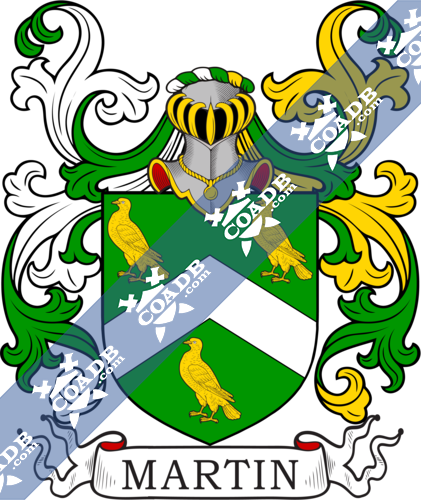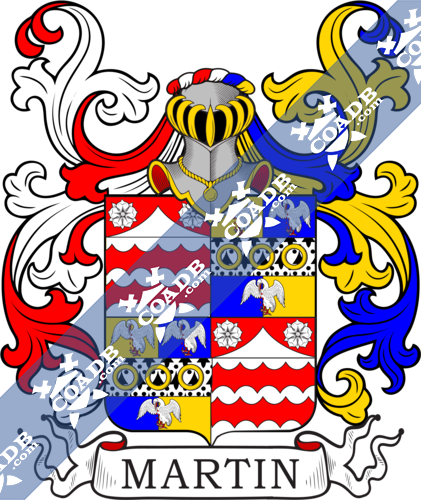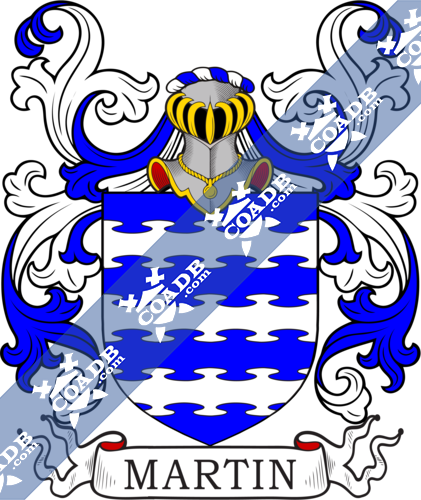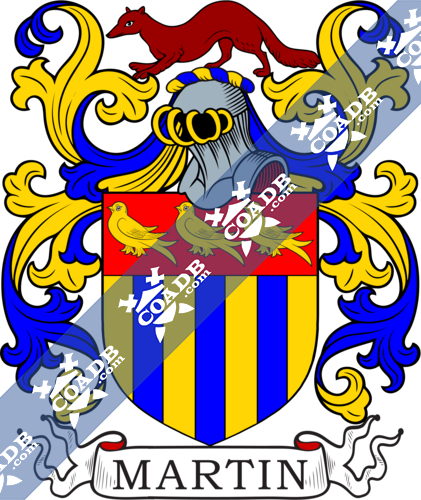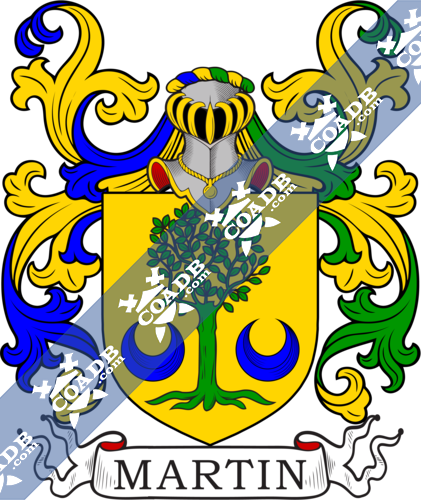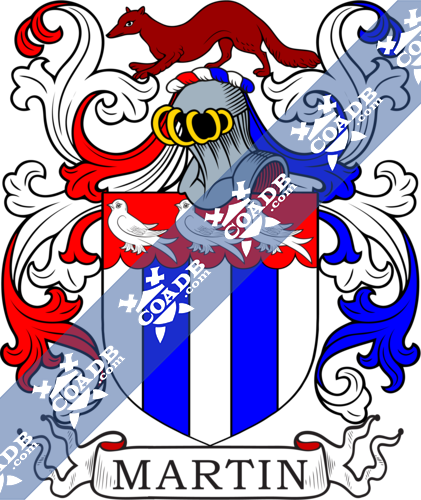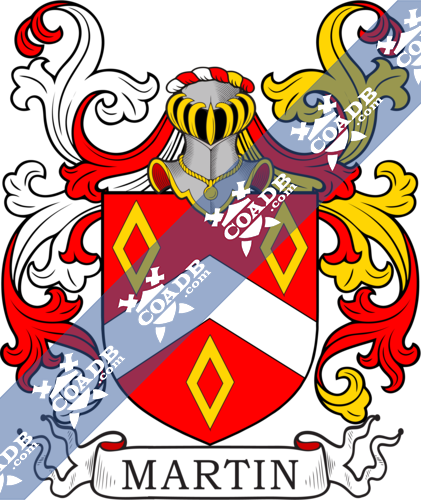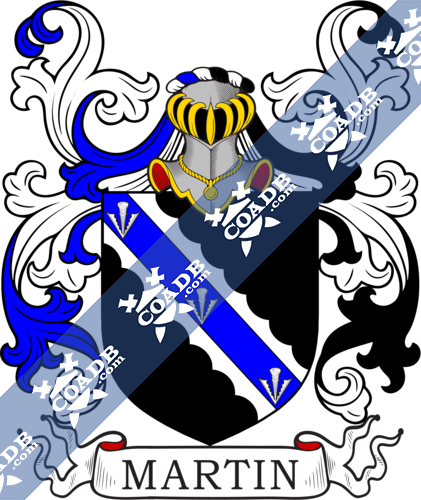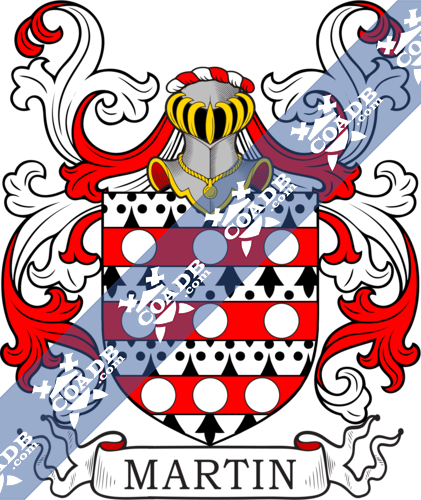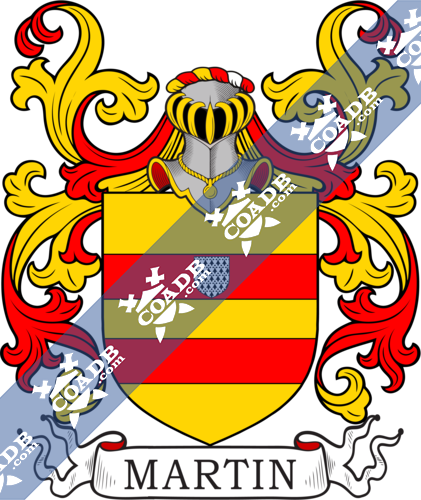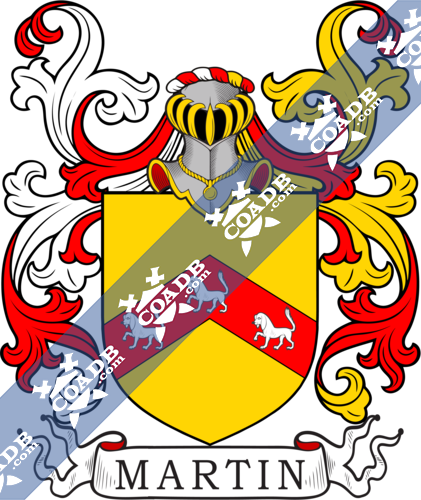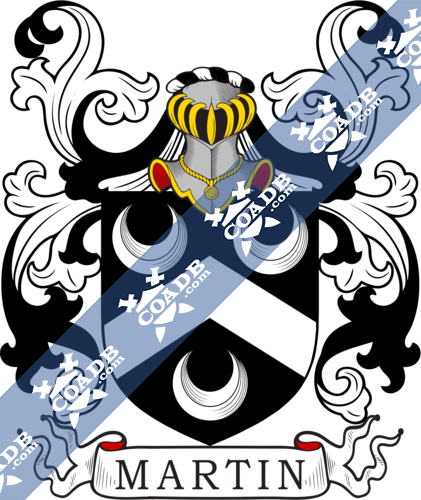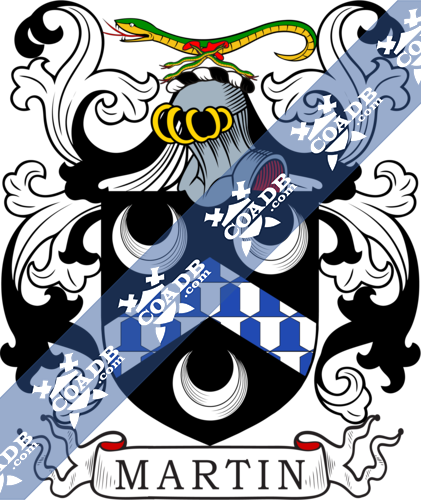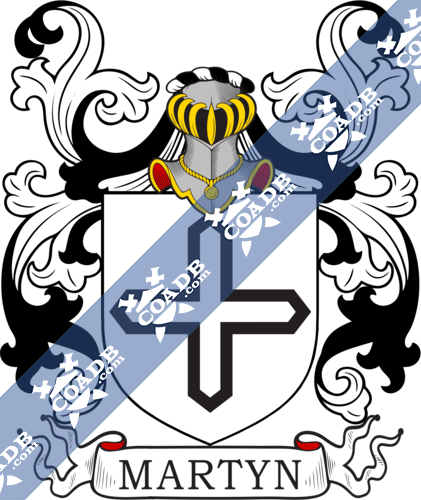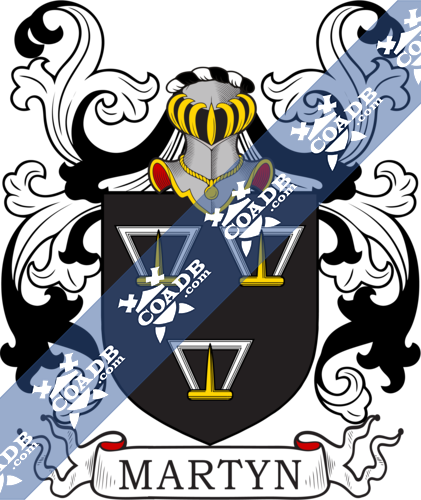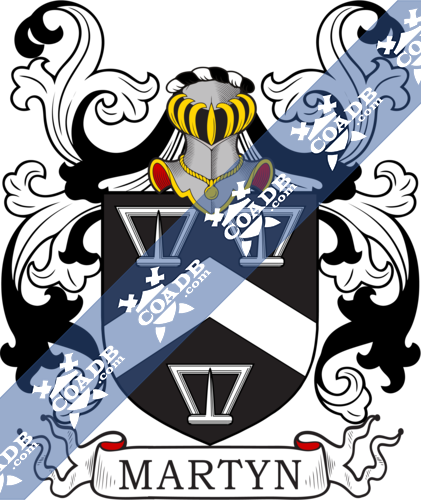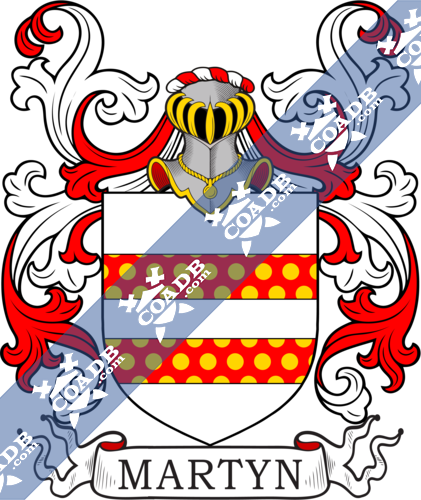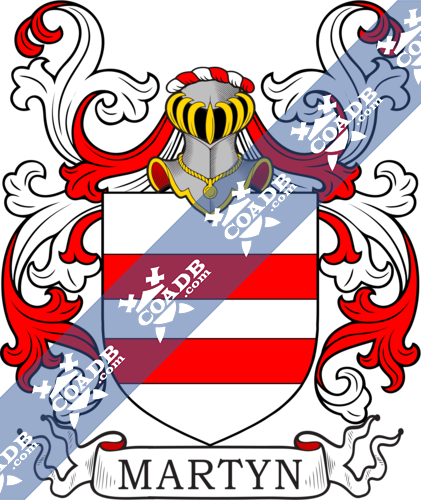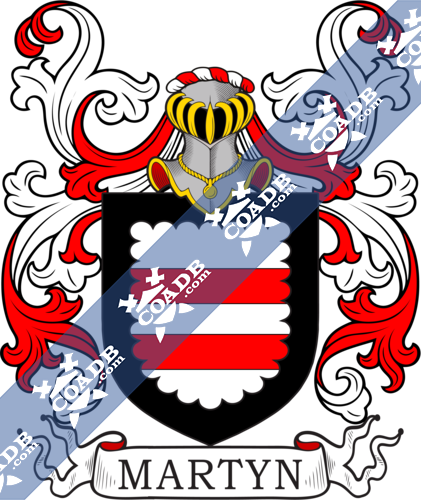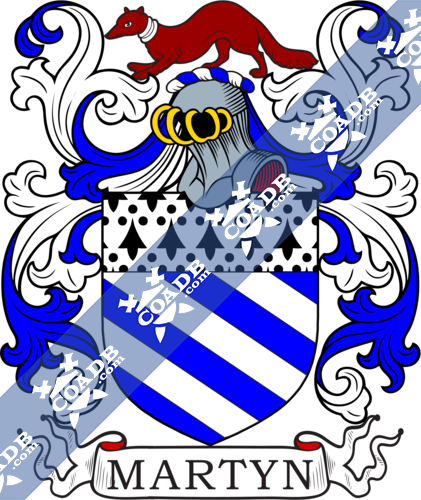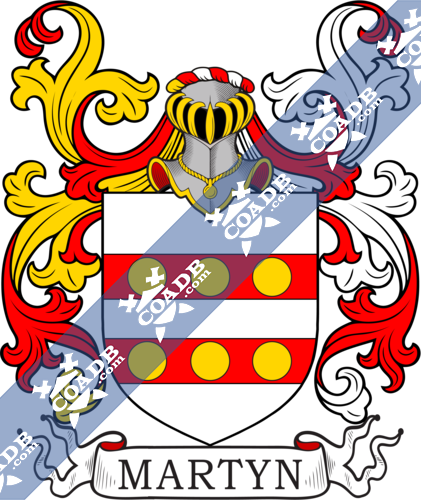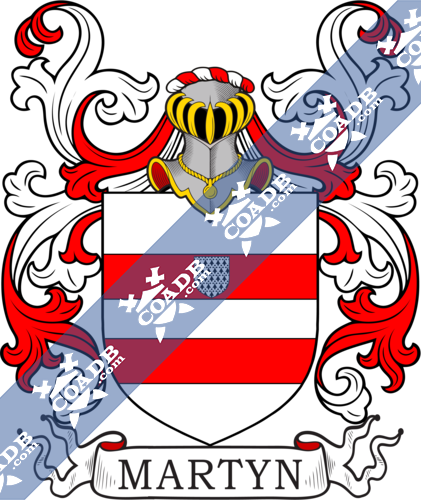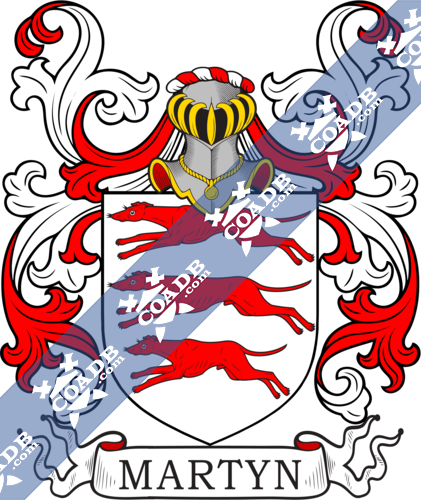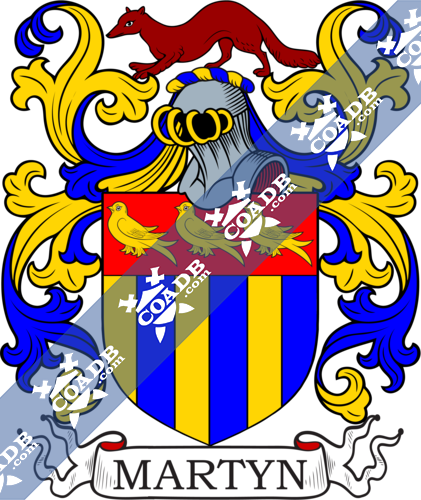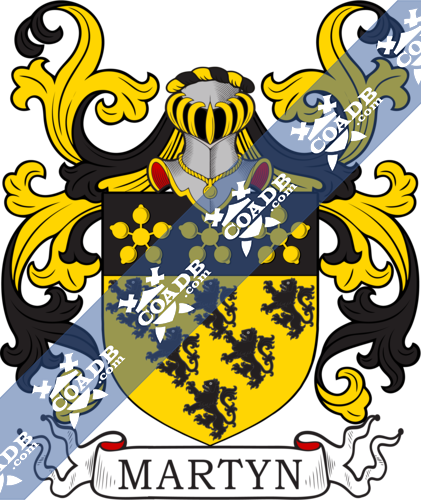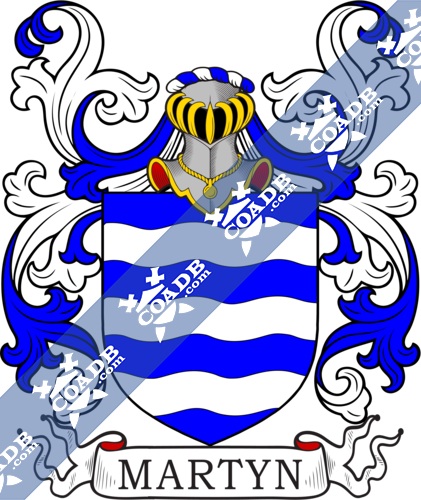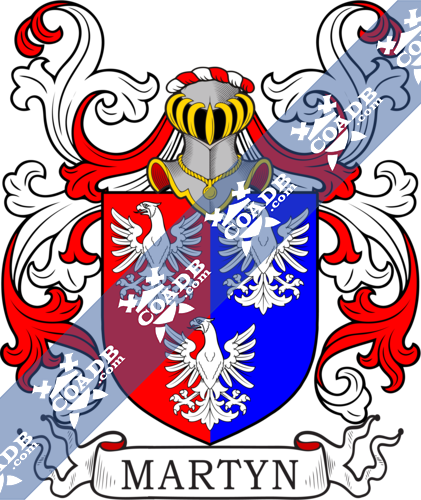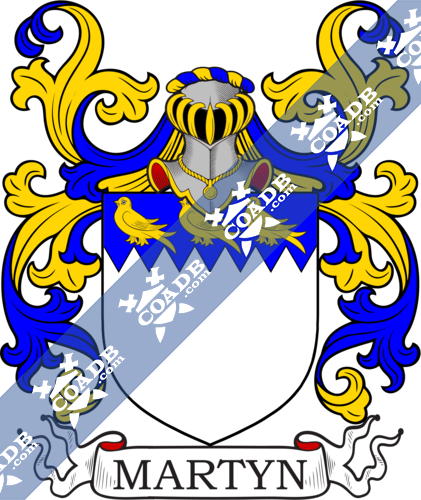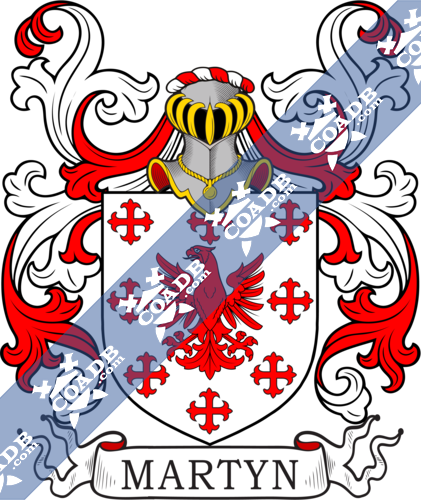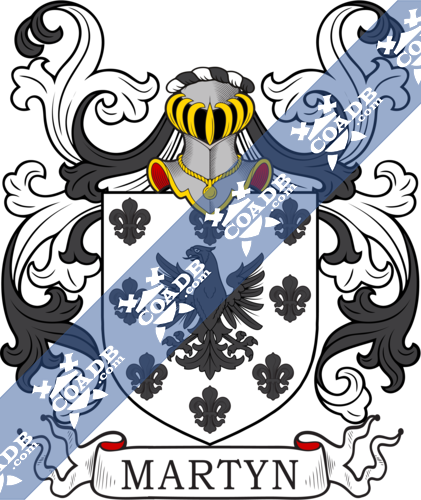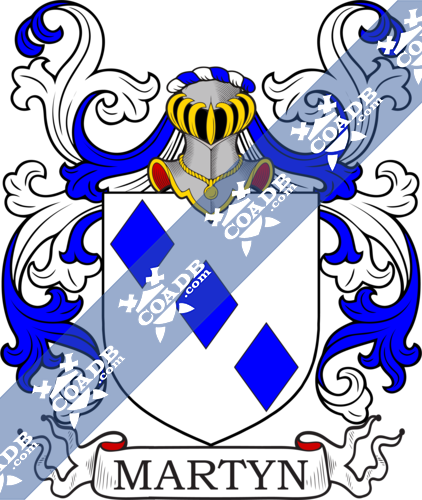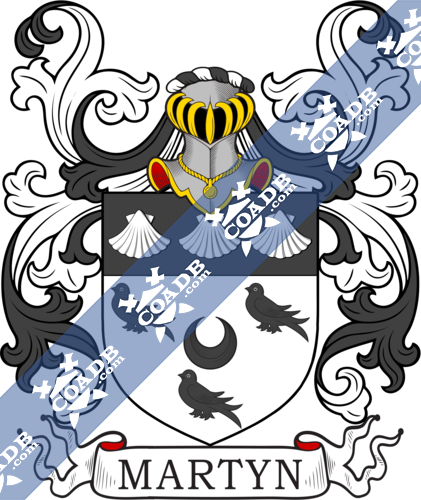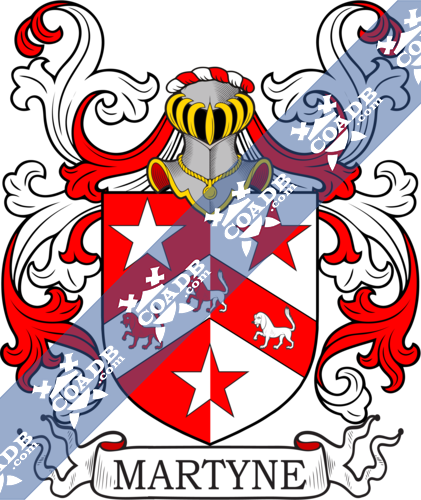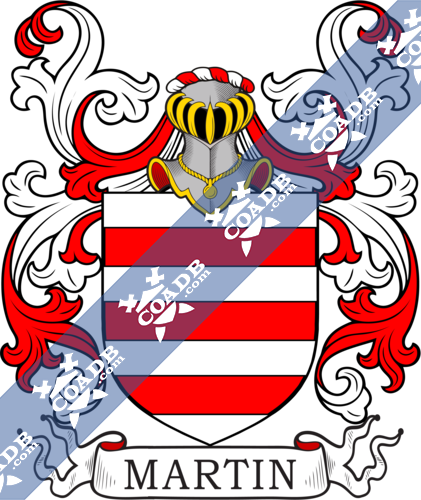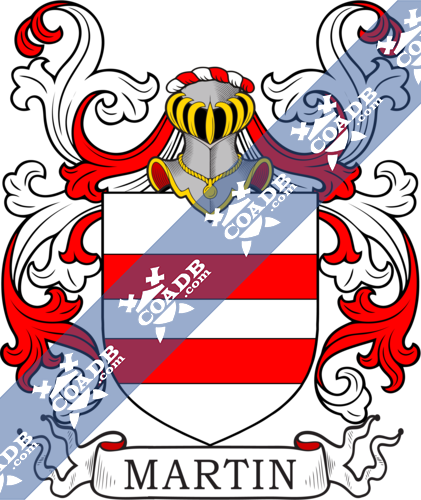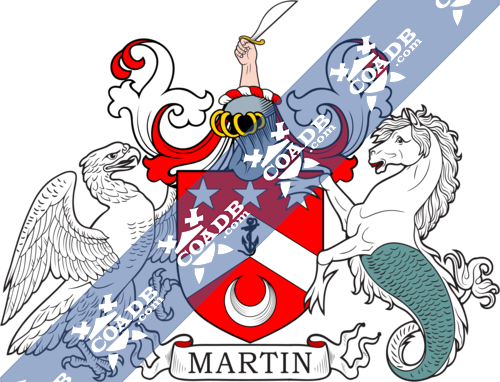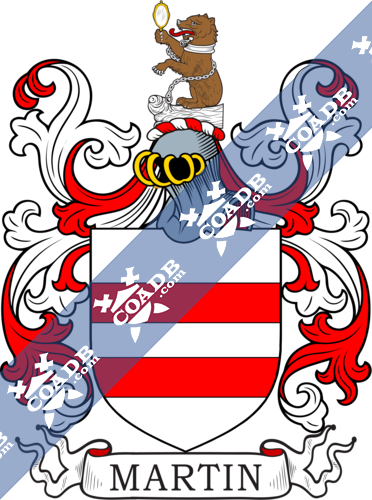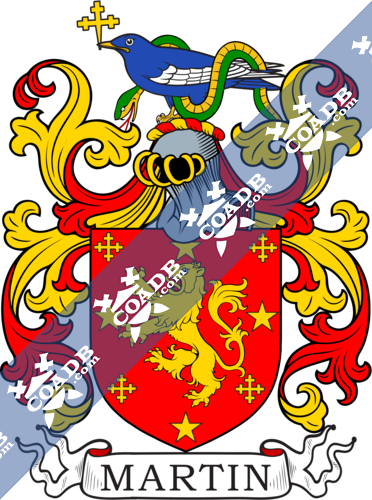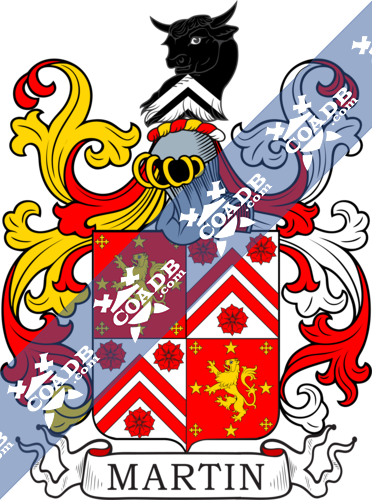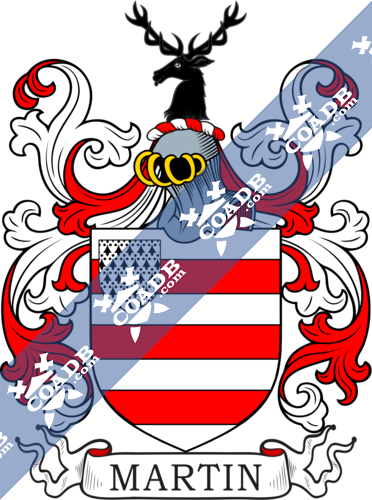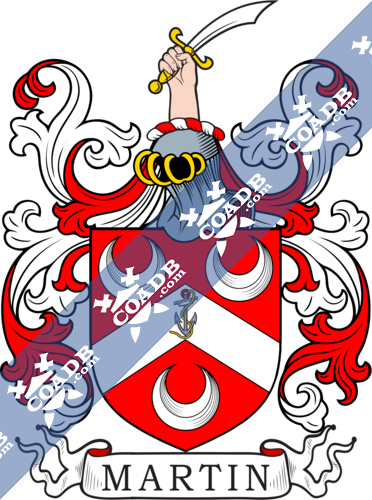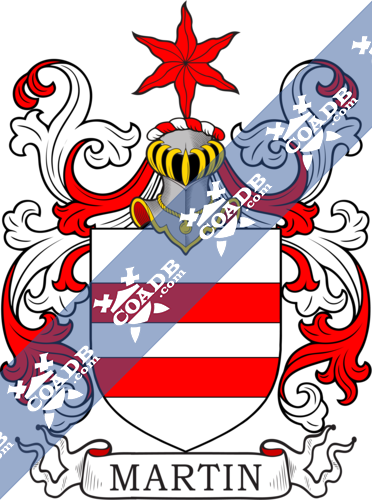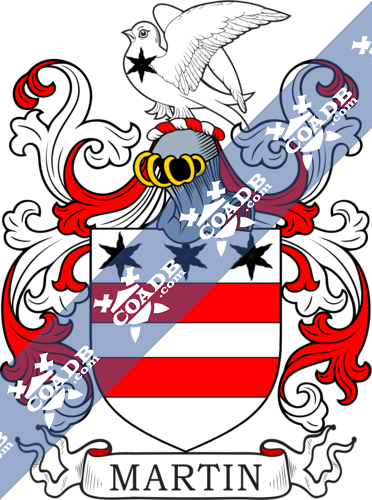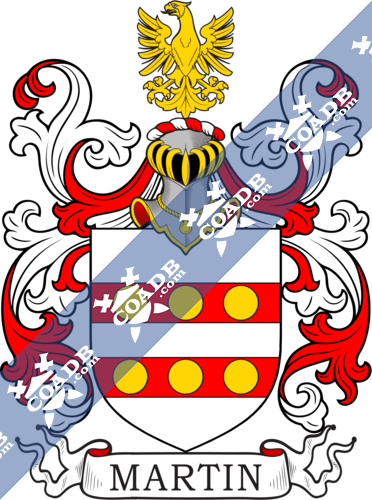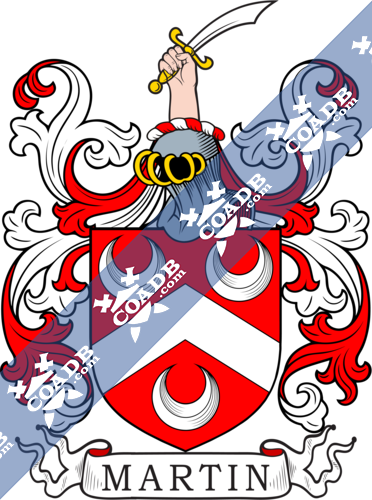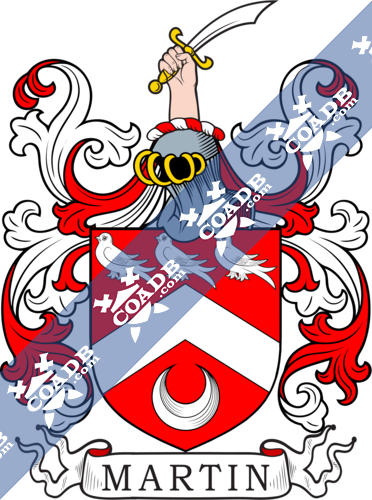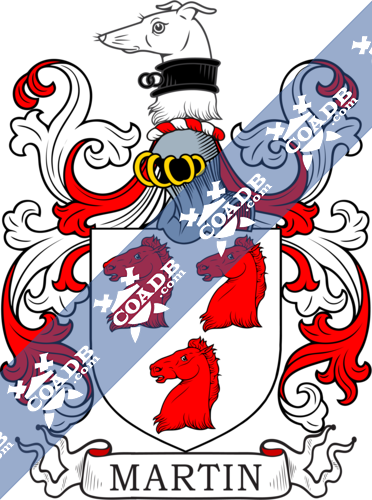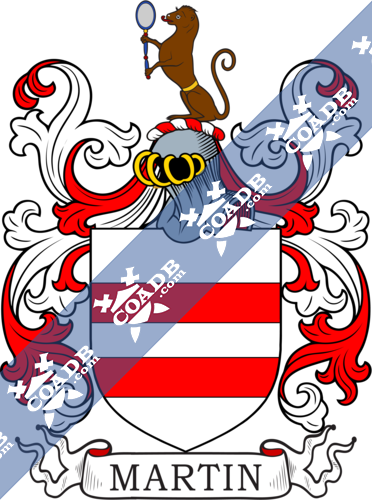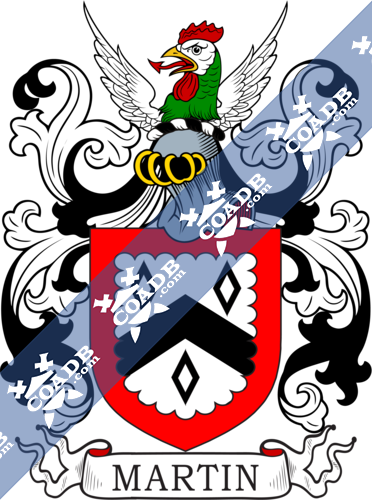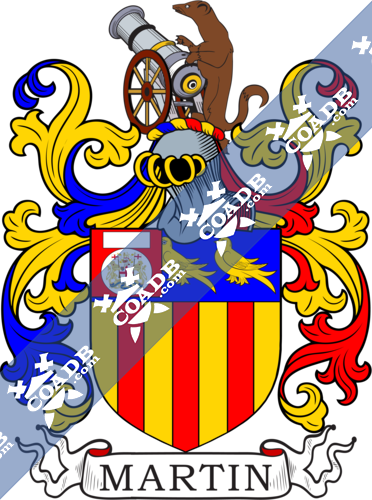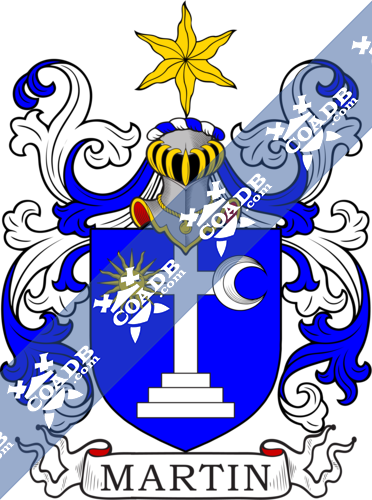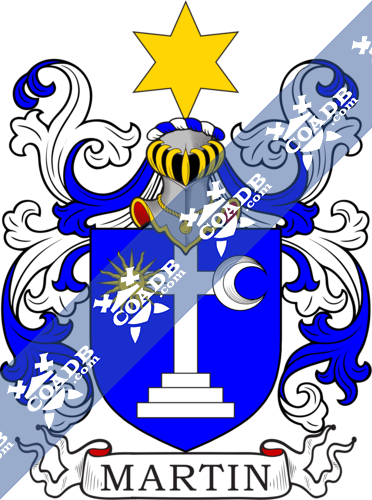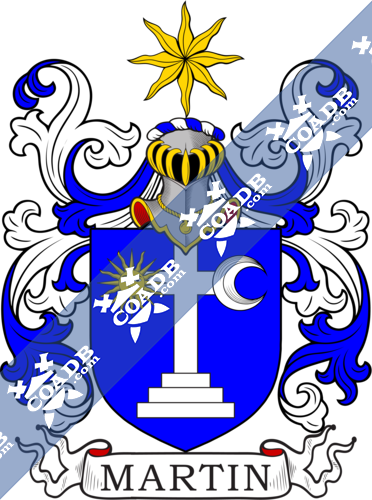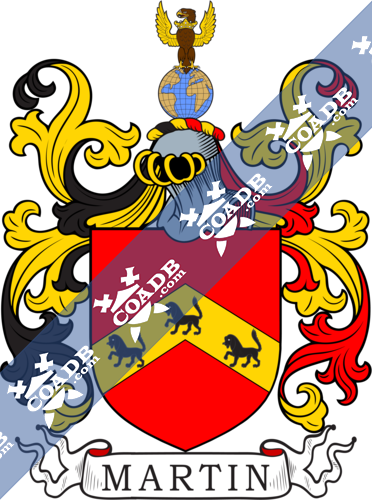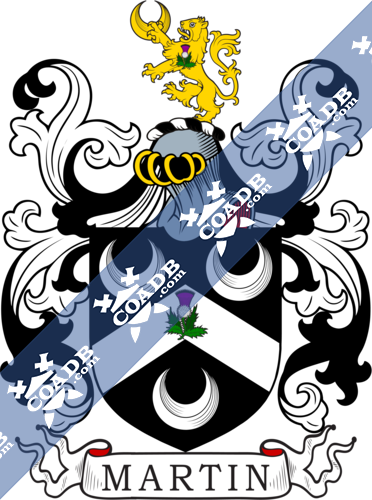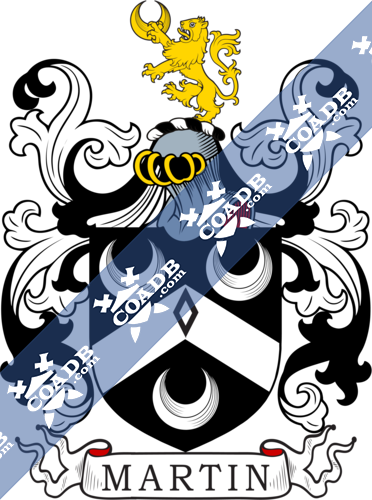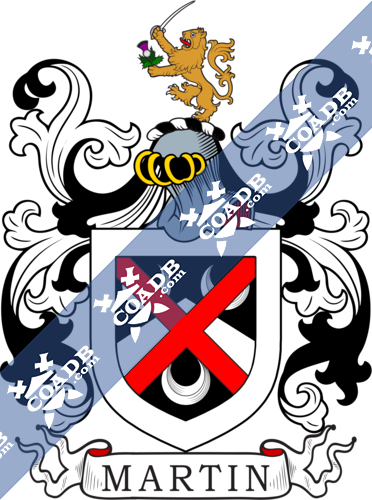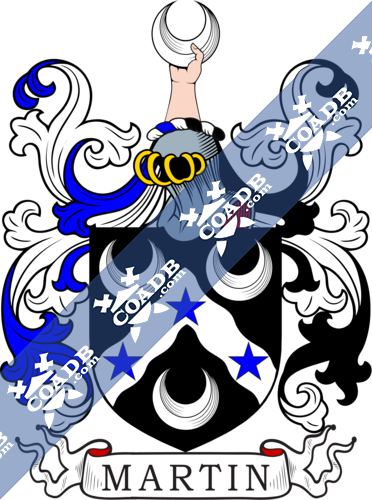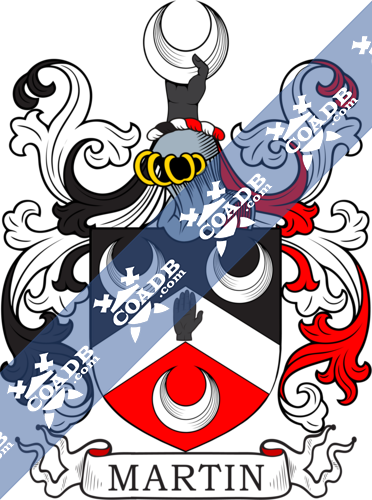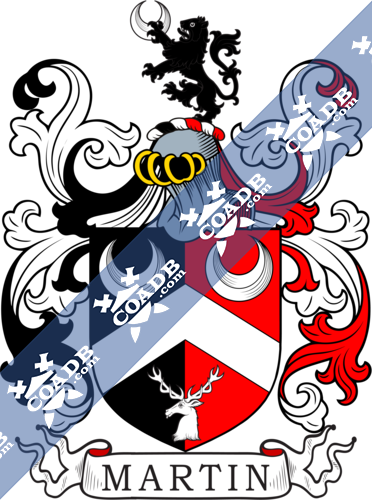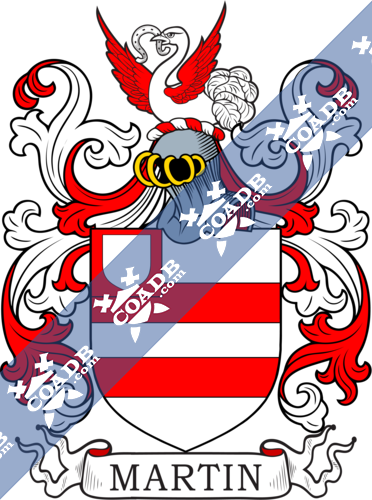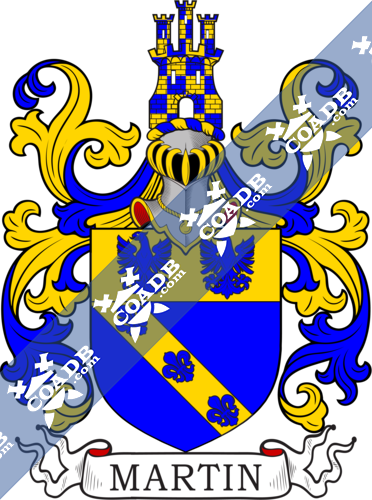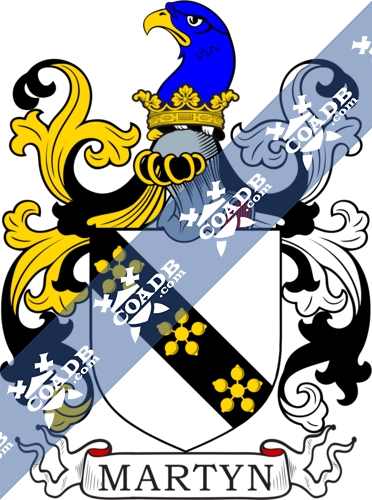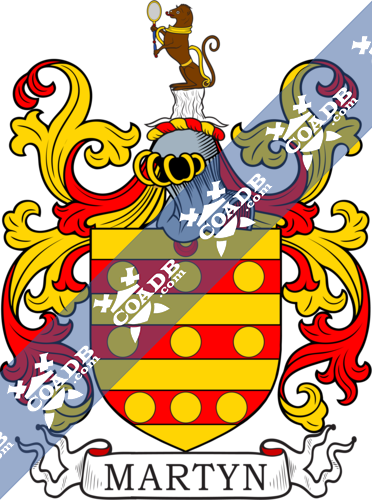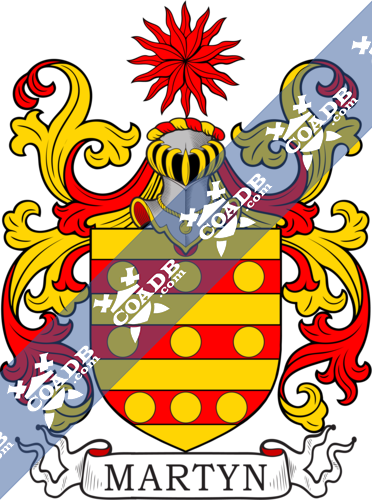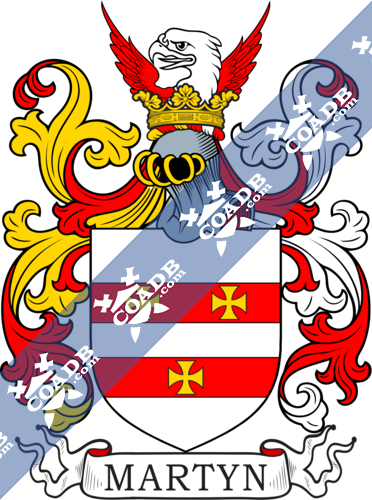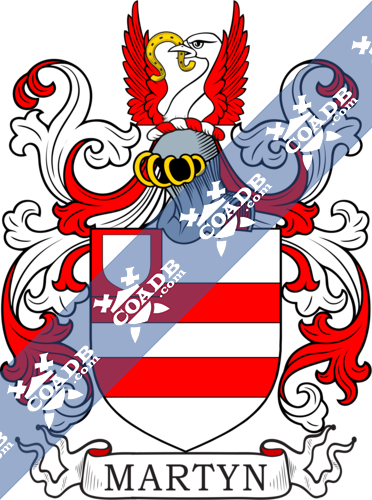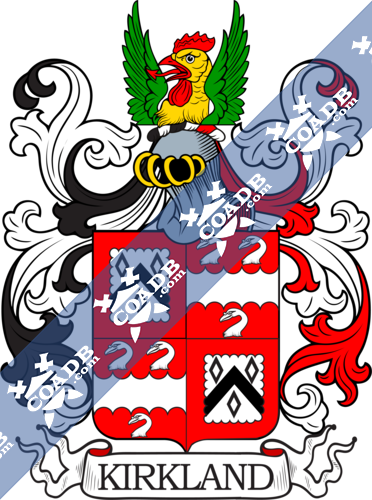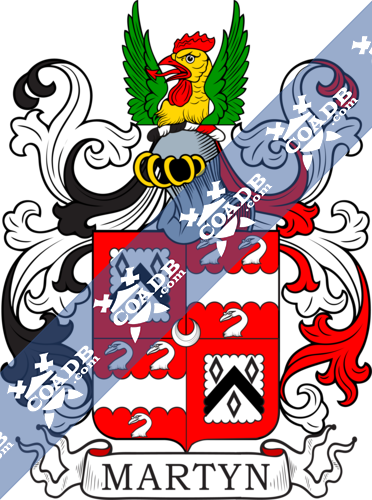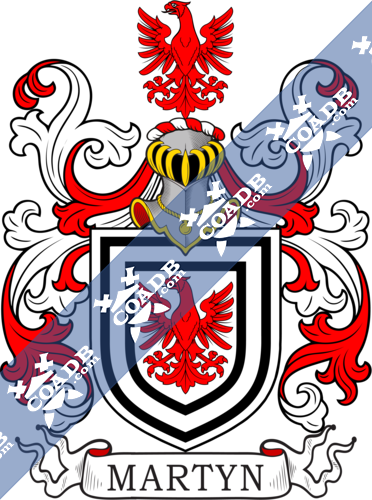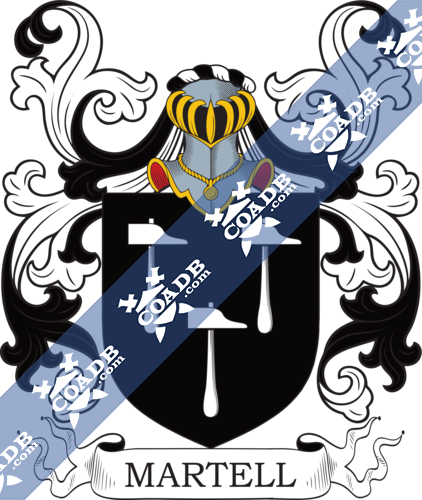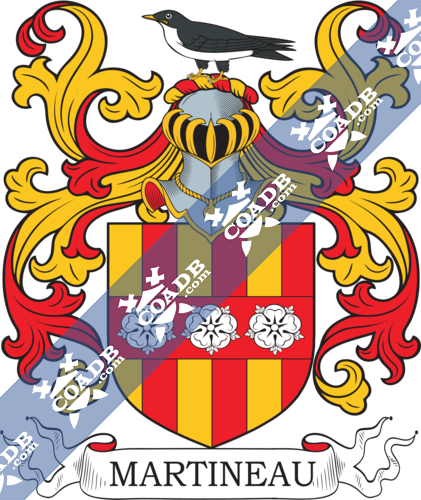Martin Family Crest, Coat of Arms and Name History
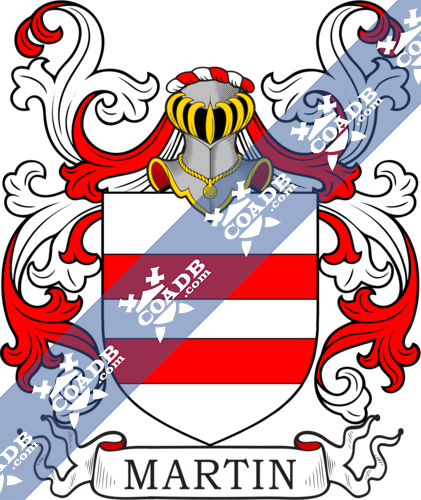
Martin Coat of Arms Gallery
Don’t know which Coat of Arms is yours?
We can do a genealogical research. Find out the exact history of your family!
Learn MoreSurname Meaning, Origin, and Etymology
Martin is an old surname from Europe, which has an interesting history, thanks to its unique and varied origin. Martin is the short version of “Martinus” an ancient surname that is derived from the word “Mars” that was the name of the Roman god of fertility and war, although there are some experts who affirm that “mars” is also a derived word, in this case, the original word is “mar” which can be translated as “to gleam”. So, here we have a surname with an etymological origin that can be traced back to the Roman Empire and then it extended across the old continent, thanks to the crusades of the 12th century carried out by the Christians to recover the holy land from the Muslims.
The popularity of Martin experimented an important boost during the 14th century, thanks to Saint Martin of Tours in France. In the Medieval Europe, there was the habit of naming the children after a Saint, to ensure that the religious figure protects the bearer during his or her life, it is a custom that still exists in some countries of the world today. Martin is not only popular among the followers of the Christian religion, thanks to Martin Luther is also popular among Protestants. Almost every European country has a version of Martin and even the patronymic forms that are derived from it are popular such as “Martinez” in Spanish, “Martenssen” in Swedish and others that are diminutives forms like “Martineau” in French and “Martinelli” in Italian. There are people who carry a locational variant because they have lived in towns called Martin, like the Polish version Marcinkowski and Marciszewski. The first record of this last name belongs to Walter Martin, who appeared in the charters of the county of Northampton, England in 1166 during the reign of King Henry II, which last from 1154 until 1189.
Martin entered in many countries in different ways and times. It arrived in England thanks to the Norman Conquest in 1066 and there were two main branches, one of them was located in Anstey-Pastures in Leicestershire, this is known thanks to an ancient church that became the family’s burial-place, and the other one in Westmeston, Sussex which is known thanks to the sale of land. With the pass of time, it became very popular in the south of Thames. In France, there was the duchy of Gascogne, which was the seat of the Martin family for many generations before the French Revolution and they started to use the name after Saint Martin of Tours. In Germany, the first time that Martin can be found is in Oldenburg, Lower Saxony, where the family was involved in the many tribal conflicts of the region and they got to be part of many noble families after making allegiances with their rivals.
In Ireland, the first records of this last name can be found in the old county of Galway in the providence of Connacht. The family received their lands by Strongbow after the Normans took Ireland in 1172. Here, the real Gaelic form of Martin was Mac Giolla Mhartian and the family center was known as Kilmartin, which was a village. In Italy, there was a record of Theobaldo Martinengo who donated 15 castles to the Empire of Otto in 953, in this country the surname also became popular thanks to Saint Martin. In Spain the surname belongs to the group of patronymic names, actually it generated the patronymic surname Martinez, and it can be found for the first time in the reign of Castile, where it was brought by the Visigoths. In the Iberian country, this surname has the feature that it is pronounced with an accent in the vocal “i”, and it has some variations according to the region, in Catalan it is Martí, in Galician is Martiño and the one took by the Jewish who remained in Spain and had to become Christian is Martí or Marty. In Scotland there were also many families with the surname Martin or Macmartins, actually, during the 14th century, they MacMartins from Letterfinlay joined forces with the Clan Cameron and after the Battle of Lochaber in 1429, the MacMartins became a sept of their allied clan.
Spelling Variations
During the middle age in Europe, one single person could have many ways to write his or her surname, and it wasn’t anything but common. This phenomenon happened for several reasons that were typical of that time and place. In those days, it existed the collision and fusion of several different cultures and with that union, it also came the fusion of languages. Not all of those languages had the written format of a regular surname of today, which means that it didn’t have any grammatical rules, so there wasn’t a correct way to spell some words. There was also the evolution of those languages, how they changed through history, the fact that some of the families added suffixes to the surname to express their loyalty or their political position or just to be distinguished from other branches and others did it to add a poetic sense to the last name. Finally, European scribes used to write words according to how they sound, and no everyone heard them in the same way, therefore, the words were written differently.
Besides all of those reasons, the surname Martin, have even more reasons to produce many spelling variations, one is that its features of having multiple locations as its place of origin. There other reason is that thanks to the wide spreading that Martin had, many countries had some particular spelling variations. In England, some of the variations are Martin, Matin, Mattin, Martyn and many more. In France the spelling variations were Martine, Lamartine, Martinat, Martinaud, Martinauld, Martinot, Martineau, Martinet, Martiné, Martinon, Martinesque, Martet, Marthet, Marté, Martaud, Martault, Martot, Marti, Marty, Martinenche, Martiena, Martirena, Martens, Mertens, Saint-Martin and others.
More countries had their own spelling variations of Martin, like Germany, where the most commons alternative forms of this surname were Martin, Martinn, Martins, Martinnes, Martinns, Marttin, Marttins, Marttines, Martines, Martinss, Marrtin, Marrttin, Martine, Marttine and many more. In Ireland, there were Gilmartin, Kilmartin, MacKilmartin, MacGilmartin and MacMartin. Italy also had some spelling variations of this popular surname, such as De Martini, De Martinis, De Martino, DeMartinis, Demartino, Martignon, Martignone, Martignoni, Martin, Martina, Martinati, Martinato, Martinelli, Martinetti, Martini, Martinilli, Martinis, Martino, Martinoni, Martinotti, an Martinuzzi. And the Spanish spelling variations of Martin were Martínez, Martinez, Martíniz, Martiniz, Martin, Martins, Martín and Marcial. In the case of the Spanish language, it is important to remark the relevance of the accent market, because its presence or absence, leads to the formation of two different words with different meanings, even when they are written the same, that is why Martínez and Martinez are considered as two variations.
Popularity & Geographic Distribution
Martin is a popular surname that has spread across the world and according to the census of 2014, it is the 214th most common surname in the word and it counts on approximately 2,258,238 bearers. The country where Martin is most prevalent is the United States and the country with the highest density are Spain. The second country with the highest amount of Martin is also Spain, followed by France in the third place and England in fourth. This is very normal, given that these last three countries are among the places of origin of the surname.
Early Bearers of the Surname
There are many of records of old bearers of Martin from different sides of the world such as John Martin from Plymouth, England who traveled with Sir Francis Drake during his first “Round the World” voyage in 1577, Pedro Martínez de Fita and Pedro Martínez de la Font, two nobleman from Castile, Spain in the twelfth century, Ferrán Martínez who wrote “Libro del cavallero Zifar” in 1300 also from Spain and other Spanish nobleman from the thirteenth century like García Martínez de Gordaliza, Ferran Martínez de Petrosa and Sancho Martínez de Leiva.
Others important old bearers of Martin were Robert Fitz Martin (1095-1159) an Anglo-Norman knight and the first Lord of Cemains in Wales, Giolla Ernain Ó Martain, a chief Brehon of law in Ireland who died in 1218, Richard Martin (1570-1618) a lawyer from London, Richard Óge Martin (1602-1648) a leading member of Confederate Ireland, Francis Martin (1652-1272) an Irish Augustinian, Martin Martin (1660-1718) a writer who explored the Hebrides from Scotland, Sir Roger Martin who was the first Martin Baronet of Long Melford, England. The list continues with Alexander Martin (1740-1807) an American politician, John Martin (1789-1854) an English painter, Christian Frederick Martin (1796-1873) a guitar builder and founder of C.F. Martin and Company from Germany, William Charles Linnaeus Martin (1798-1864) an English naturalist, Luther Martin (1748-1826) American politician and Richard Martin, an English cricketer who was born in 1789.
History, Genealogy, and Ancestry
Thanks to the popularity of Martin across whole Europe, there are many records of different families with that surname. Given the nature of Martin and its many places of origin, it is a last name that counts on many lines that are not related to each other. These lines are from different countries such as England, which is the home of the Martin of Ham Court. The leader of this family was George Edward Martin, Esquire of Ham Court a Captain in the Queen’s Own Worcestershire Ycomanry Cavalry, Lord of the Manor of Upton, who was born on November 11, 1829, and on October 15, 1862, got married to Marie Henrietta, daughter of Benjamin Cherry, Esquire of Brickendon Grange and Charlotte Casandra.
George Edward Martin and Marie Henrietta had the following children Eliot George Bromley who was born on October 2, 1866, Granville Edward Bromley who was born on October 18, 1875, Charlotte Susan Henrietta who was born on January 3, 1864, Madeleine Frances who was born on June 4, 1865, Eleanor Mary who was born on November 14, 1869 and Annora Margaret who was born on April 7, 1872.
The lineage of this family began with William Martin, Esquire of Evesham who in 1678 got married to Elizabeth Knight, daughter of John Knight, Esquire of Barrels and Joan Rawlings. Their sons were Thomas, who was a banker of Lombard Street and got married to Elizabeth Lowe, daughter of Richard Lowe of Cheshunt, Herts, the second son was William, Barristar-at-Law who married Laura Morrelli, John, from who we will talk later and James, who also became a banker from Lombard Street and in 1721 bought the estate and Manor of Quy. The third son, John Martin became the Esquire of Quy Hall and got married to Catherine Jackson, daughter of Joseph Jackson, Esquire of Sneed Park.
The children of John and Catherine were John of Quy Hall and Overburry who got married to Judith Bromley, heiress o Ham Court, but they didn’t have any children. The second son was John, who will be treated at the end of this generation, and the third son was James, who got married to Penelope Skipp, daughter of John Skipp, Esquire of Upper Hall. They had three sons and four daughters. The first son was John who was born on February 27, 1774 and in March 5, 1803, got married to Frances Stone, daughter of Richard Stone, Esquire of Chislehurst, Kent and their children were John who was born on February 2, 1805 and got married for a first time to Mary Aubrey, daughter of Captain Thomas Aubrey Morse on October 1, 1837 and they had one daughter, Flinor Traherne, then Mary died in 1843. John got married for a second time to Maria Henrietta, daughter of Evan Hamilton Bailie, on January 7, 1847.
The children of John and Maria Henrietta were John Hamilton, Waldyve Alexander Hamilton, Hugo Hamilton, John Evan Hamilton, Edith Hamilton, Ada Hamilton, Dora Hamilton, Nora Hamilton and Frances Hamilton.
The second child of John and Frances was Richard who died as an infant, then there was James who was born on May 18, 1807 and then Robert, of Overburry who was born on August 14, 1808 and on April 20, 1837 got married to Mary Anne Biddulph, daughter of John Biddulph, Esquire of Ledbury and their children were Richard Biddulph who got married to Mary Crozier, the daughter of Admiral Richard Crozier, John Biddulph and Julia Biddulph who got married to Douglas, the eldest son of George Henry, Esquire of Chislchurst. The rest of the children of John and Frances were Henry, and Emily who in 1830 got married to Robert Cumming Norman, Esquire of Bromley.
The second son of James and Penelope was Joseph, who got married to Sarah Harrlet, daughter of Robert Hewit, Esquire of Whitehaven and the third son was James who on September 20, 1819, got married to Julia Vignoles, daughter of Reverend John Vignoles, from Portarlington. The daughters of James and Penelope were Penelope, Catherine, Elizabeth, and Anne.
The second son of John Martin and Catherine Jackson, also named John Martin was the Esquire and banker of Lombard Street and married Eleanor Torriano, daughter of Sir John Torriano and Eleanor Mann and had four sons and three daughters. The sons were Thomas, of Quy Hall who died in 1821, Joseph, who will be explained later, Charles who became a Lieutenant-Colonel in the army and got married to Elizabeth Williams, daughter of Salomon Williams, Esquire of Dublin.
The offspring of Charles and Elizabeth was: Charles Herbert who became a reverend and got married for a first time to Eliza Porter, the second daughter of William Sloane, Esquire of Tobago in 1818 and with her he had three daughters: Henrietta Ann Bidgood who on August 3, 1843, got married to Samuel White Baker, Eliza Heberden who got married to John Garland Baker on August 3, 1843, and Charlotte Louisa. Charles Herbert got married a second time to Frances Anne Goodwin, daughter of Joseph Goodwin, and had two children, Charles Frederick and Gertrude Eleanor Frances.
The second child of Charles and Elizabeth Williams was John Williams, of Twinning who got married a first time to Jane Clarke, but she died without leaving offspring. Then John got married for a second time in 1841 to Sophia Bashford, daughter of William Whitehouse and had one son, Charles Stanhope. Charles and Elizabeth Williams also had a daughter, Eliza, who got married to James M. Cabe.
The fourth son of John Martin and Eleanor Torriano was George, who became a reverend and the Vicar of Overburry and got married to Maria Clarke, daughter of Richard Clarke and they had only one daughter named Maria, who got married to William Hill Buckle, Esquire of Chaceley. The daughters of Joseph Martin and Eleanor Torriano were Eleanor, who got married to J. Foote, Mary who got married to Reverend Thomas Heberden and Anna, who got married to Joseph Smith.
The second son of Joseph Martin and Eleanor Torriano was also who was also named Joseph Martin, of Ham Court, he became a reverend and the Lord of the Manors of Upton-on-Seven, and of Cheshunt, Herts, and the Rector of Bourton-on-the-Hill. In 1786, He got married to Isabella Margaret, daughter of Rev. John Sturges. The children of Joseph Martin and Isabella Margaret were Joseph John, late of Ham Court, George, who became a reverend and got married for a first time to Charlotte Sophia Eliot on July 26, 1825, and their children were George Edward, Henry Arthur, Georgina, Susan Isabella, Charlotte Harriet and Jemina Ann Frances who got married to Colonel Charles Cooper Johnson in 1860.
The second wife of George Martin was Renira Henrietta Aldenburg, the daughter of William Bentinck. They married on July 21, 1842, and their children were Albert Bentinck, Evelyn Charles, Renira Isabella, Emily Frances and Lucy Annora.
The third child of Joseph Martin and Isabella Margaret was Henry who died in 1813 and the fourth was William, who became a reverend and the Vicar of Staverton. He got married to Jane Champernowne, the eldest first daughter of Arthur Champernowne, Esquire of Dartington, Devon. Their children were William, Arthur, Richard who got married to Eliza Rose Fearon, daughter of Rev. Daniel Rose Fearon, the Vicar of Saint Mary Church in Devon, Francis, Charles the Warden of Radley Coll, who got married to Dora Frances Moberley, Alfred John, John Harington, Reginald, Caroline, Frances who in 1852 got married to Rev. Jos, Lloyd Brereton, Prebendary of Exter, Mary Isabella, Anne and Louisa Renira.
The fifth son of Joseph Martin and Isabella was Francis, but he died without getting married, the sixth was Richard, who became a reverend, and the Canon of Truro and Vicar of Menheniot, he got married to Charlotte, the eldest daughter of Rev. J. W. Baugh. The following son was John Sturges who didn’t get married and the daughters Isabella Margaret, Eleanor, Anne, and Frances.
The eldest son of Joseph and Isabella, Joseph John Martin became the Esquire of Ham Court and the Major of Worcestershire Ycomanry for many years and after his death in 1873, was succeeded by his nephew.
Another branch of Martin was the Martin of Hemingstone, which head of the family was William George Martin, Esquire of Hemingstone Hall, in England. He was born on August 5, 1835, and on May 19, 1865, got married to Margaret Strahan, the second daughter of William Strahan, Esquire of Sidmouth. They had a daughter named Beatrix Maria. This lineage began with Captain Roger Martin, son of Roger Martin of Stepney, he got married for a first time to Elizabeth Tutchen and the second time to Thomasina. He only had one son, Tutchen Martin, who got married to Bennet Garsh, and died in 1702, not before having a son, William Martin, who became an Admiral, Mary Atkins, Bennet, who will be explained at the end of this generation, Roger who also was an Admiral and James.
Bennet Martin, the third son of Tutchen Martin had a son, Capt. William Martin who got married to Arabella Rowley, daughter of Admiral Sir William Rowley. The children of Bennet and Arabella were William, of Hemingstone, the heir, Henry, of Colston Bassett who got married on July 14, 1795, to Maria Elizabeth Edmunds, George who was a Vice-Admiral and got married to Harriet Bentinck for a firs time and to Miss A. Locke for the second time.
The heir, William Martin, Esquire of Hemingstone and Captain in Elliott’s Horse, got married to Sarah Rowley, daughter of Admiral Sir Joseph Rowley and their children were William, who died without having any children, Richard Bartholomew, who will be explained later, Eliza who got married to Rev. Charles Townley, Arabella and Maria. The second son, Richard Bartholomew Martin, Esquire of Hemingstone got married to Juliana Donovan, daughter of John Donovan, on April 5, 1832 and their children were William George, now of Hemingstone, Charles Townley who became an officer in the army and died drowned, Henry John who became a Lieutenant, Richard Edward Rowley, Francis, Joshua Gibbs, Maria Elizabeth Verner who in 1856 got married to Rev. John Longe, Rector of Saint Mary Elms and Sarah Juliana Philadelphia who died while still being an infant. William Martin died on April 11, 1855.
Coat of Arms
Thanks to the several branches of Martin, this surname has had many coats of arms. The coat of arms that belonged to the Martin of Ham Court was composed by paly of sex on a chief and three martlets of the first with a martin passant. The coat of arms of the Martin of Hemingstone was composed by two bars and an ape looking at itself in a crystal. Another coat of arms of Martin consisted in a chevron between three crescents, an anchor erect with a cable and a dexter hand brandishing a saber.
Early American and New World Settlers
Since the 16th and 17th centuries, many Europeans started to travel to many countries of America to start a new life or to explore the new territory. They brought their surnames with them, and this is how in the last names of Europe started to be used in the new continent. Some of the bearers of Martin that arrived in United States during the 17th century were John Martin who landed in Virginia in 1606, Christopher Martin who arrived in America in 1620, another Christopher Martin who arrived in Plymouth also in 1620, Giles Martin who landed in New England in 1623 and Simon Martin, who landed in Saint Christopher in 1633. In the 18th century, Adam Martin landed in Charles Town, South Carolina in 1782.
During the next century more bearers of Martin arrived in United States such as Charles Martin, who arrived in New York in 1803, Barbara Martin who landed in Pennsylvania in 1806, Andrew Martin who landed in New York in 1811, James Martin who also arrived in New York but in 1820 and August, Edmund and Belfort Saint Martin who landed in New Orleans in 1820.
The United States was not the only country of America in receiving bearers of Martin, another nation which also did it was Canada. In the 17th century, this nation received Bernard Martin who arrived in Acadia in 1636 and Pierre Martin who also arrived in Acadia in 1636. At the next century, more specifically in 1784, Mr. Adam Martin U.E., Mr. Amos Martin U.E., Mr. Andrew Martin U.E., Mr. James Martin U.E. and Mr. John Martin U.E. arrived in Saint Andrews. Charlotte County, New Brunswick. The initials U.E. stand for “United Empire” this was a way to distinguish those people that kept loyal to the English Crown during the independence revolution of United States, they moved to Canada after being exiled.
In the 19th century, more carriers of Martin arrived in Canada such as Christian Martin who arrived in Canada in 1831, Thomas Martin, Johanna Martin, William Martin and Jane Martin arrived in Saint John, New Brunswick in 1833.
Mottoes
Mottoes were used to families to express their way of living, their code of conduct or to whom they were loyal. In some cases, the family included the motto in their coat of arms. The most important mottoes for the Martin family were:
- “Auxilio ab alto” which means “By aid from on high”.
- “Auxilium ab alto” which means “Aid from above”
- “Fide et clemencia” which means “by faith and clemency”.
- “He looks at Martin’s ape, Martin’s ape will look at him”.
- “Hinc fortior et clarior” which means “Hence the stronger and more illustrious”.
- “Initium sapientie est timor Domini” which means “The fear of the Lord is the beginning of wisdow”.
- “Ingratis servire nefas” which means “He fosters the polite arts”.
- “Pejus letho flagitium” which means “Disgrace is worse than death”.
- “Sans tache” which means “Without stain”.
- “Sic itur ad astra” which means “Such is the way to immortality”.
- Sure and steadfast.
- “Votis, tune velis” which means “By wishes, then by sails”.
Grantees
There are records of several grantees of Martin in history such as Cuthbert Martin from London who had the charge of Esquire and was made Knight, Matthew Martin who was a captain in 1722, Phelps Martin of Withy Bush, Edwin Martin to Atkins of Priory and Kingston Lisle, who was a Chaplam, Tomas Martin of Ham court and Poole House, Overburry, Francis Martin, Wykeham Fiennes Martin of Chalcombe Priory in 1821, Admiral Sir George Martin of Hemingstome in 1822, Sir James Martin who was the First Minister and Attorney-General of Clarens DistrictDarlingbursht, Wales, E. Pritchard Martin of Dowlais, Wales in 1894, John Martin of Darley Hall and Worsborough, Darfield in 1880 and J.A. Napier Martin of West Leight, Havant, Hampsh in 1888.
Notables
There were several bearers of the surname Martin who have played important roles in many fields such as Sir George Martin (1926-2016) an English music producer who won a Grammy Awards on six occasions, he produced songs for important bands like The Beatles, Shakira Martin (1986-2016) a Jamaican model who was Miss Jamaica Universe in 2011, George R.R. Martin (b. 1948) an American science fiction and fantasy writer who is the author of the great saga “A son of ice and fire”, the series of book which inspired the TV series “Game of Thrones”, Bob Martin (1922-1998) an Austrian singer, Barney Martin (1932-2005) an American actor, Jacques Martin (1921-2010) a comic creator from France, Cristopher Anthony John Martin (b. 1977) better known as Chris Martin, the singer of the British band Coldplay, Millicent Martin (b. 1934) an English actress and singer and Steve Martin (b. 1945) an American actor, comedian, musician and author.
Blazons & Genealogy Notes
1) (Baron Martin, abeyance 1325; William Martin, descended from Robert Martin, temp. Henry I., son of Martin de Tours, a Norman, was summoned to Parliament, 1295). Ar. two bars gu.
2) (Lockynge, co. Berks, bart.). Gu. on a chev. betw. three crescents ar. an anchor erect and cable ppr. Crest—A dexter hand brandishing a sabre ppr. pommel and hilt or. Motto—Auxilium ab alto.
3) (Long Melford, co. Suffolk, also of Burnham, co. Norfolk, bart.. extinct). Ar. a chev. betw. three mascles sa. a bordure engr. gu. Crest—A cockatrice’s head betw. two wings. Another Crest—A martin pass. ppr. Motto—lnitium sapientiæ, est timor Domini.
4) (Plymouth, co. Devon; John Martin, aged 70, Visit. Devon, 1620, “who went round about the world with Sir Francis Drake, anno 1577,” fourth in descent from William Martin, fourth son of Richard Martin, Esq., of Poulehurst, co. Kent; arms confirmed by Dethick, Garter, 24 Queen Elizabeth, anno 1581). Gu. on a chev. or, three bloodhounds pass. sa. Crest—On a celestial globe sans frame an eagle ppr. wings displ. or, ducally gorged gold.
5) (Exeter, co. Devon; Nicholas Martin, Visit. Devon, 1620, son of Ricchard Martin, and grandson of Sir William Мartin, Knt., by Christian Paulet, his wife, dau. of Sir William Paulet, Knt., of Hinton St. George, co. Somerset, temp. Henry VI., ancestor of the Earl of Powlett, the Marquis of Winchester, and Lord Bolton). Ar. two bars gu. a crescent for diff. Crest—An estoile gu.
6) (co. Durham). Ar. two bars gu. on a canton of the second an inescutcheon of the first. Crest—A demi ostrich erased ar. wings elevated gu. and in the mouth a horse shoe.
7) (or Martain). (Bowton, co. Cambridge, 1604). Az. on a bend or, three fleurs-de-lis of the first, on a chief of the second two eagles displ. of the field. Crest—A tower triple-towered chequy or and az.
8) (Bodmin, co. Cornwall; the co-heirs m. Trefusis and Winter, temp. Henry IV.). Ar. three bars gu.
9) (Athelhampston, co. Dorset). Ar. two bars gu.
10) (or Martyn). (Exeter, co. Devon; a branch of Martin, of Athelampston; the last male heir, William Clifford Martin, Esq., d. in 1769). Same Arms. Crest—On the trunk of a tree ar. a bear sejant ppr. chained of the first holding a mirror or.
11) (East Court, co. Kent). Vert a chev. ar. betw. three doves or.
12) (co. Leicester: Robert Martin, of an old family of the county, acquired the estate of Anstey Pastures, in the 16th century). (Whatton House, co. Leicester). Per saltire ar. and or, three martlets betw. two bars gu., quartering the arms of Richards, of Normanton, viz., Ar. a chev. invected betw. two escallops in chief and a cross pattée in base gu. Crest—A talbot’s head erased ar. crusilly eared and langued gu. gorged with a collar vert. Motto—Sure and stedfast.
13) (Francis Martin, Bluemantle, 1796, afterwards Norroy and Clarenceux King of Arms). 1st and 4th, ar. two bars engr. gu. in chief a mantle betw. two roses; 2nd and 3rd, quarterly, or and az. on a fesse erm. betw. three pelicans vulning three annulets.
14) (co. Dorset). Ar. two bars gu. each charged with an annulet or.
15) (Leeds Castle, co. Kent: General Philip Martin, the last male heir, d. s. p.). Gu. a lion ramp. within an orle of crosses corsslet and mullets alternatively or. Crest: A martin entwined by a serpent ppr. in the beak a crosslet fitchee.
16) (Wykeham-Martin, Chacombe Priory, co. Northants, and Leeds Casile, co. Kent; Fiennes Wykeham, S. his kinsman Gen. Philip Martin, in the family estates, and assumed the additional surname of Martin; he was son of Rev. Richard Wykeham, by Mary Fox, his wife, dau. and heir of Сharles Fox, Esq., of Chacombe Priory, who was the great grand daughter of Joseph Martin. Esq., of Ripe, co. Sussex). Quarterly, 1st and 4th, gu. a lion ramp. or, an orle of crosses crosslet and mullets alternately of the last, for Martin; 2nd and 3rd, ar. two chevronels betw. three roses gu., for Wykeham. Crest—A bull’s head erased sa. charged with two chevronels ar.
17) (cos. Somerset and Devon; borne by Richard Martin, of Old Quebec Street). Ar. on two bars gu. three crosses formée or, two and one. Crest—An eagle’s head betw. two wings issuant from a ducal coronet all ppr. Motto—Accendit cantu.
18) (cos. Kent and York). Or, three bars gu. in the dexter corner an escutcheon erm. Crest—A stag’s head sa.
19) (London; granted Aug. 1615). Аг. three bends ar. a chief erm. Crest—A wood martin ppr. collared ar.
20) (Exeter, and Kemys, co. Pembroke; temp. Henry I.). Ar. two bars gu. Crest—An estoile gu. Another Crest—A leopard’s head erased ppr.
21) (founder of Martin College, Oxford). Or, three chevronels per pale az. and gu.
22) (Bangor, co. Carnarvon, and London, 1634). Ar. two bars gu. in chief three estoiles sa. Crest—A martlet rising, ar. charged on the breast with an estoile sa.
23) (co. York). Ar. two bars gu. each charged with three bezants. Crest—An eagle displ. or.
24) (co. York). Az. three bars nebulée ar.
25) Gu. a chev. betw. three crescents ar. Crest—A cubit arm erect ppr. brandishing a scymitar, blade ppr. hilt and pommel or.
26) Gu. a chev. betw. three martlets in chief and a crescent in base ar. Crest—A dexter arm erect ppr. holding a scymitar of the last, hilt and pommel or.
27) Ar. three nags’ heads erased gu. Crest—A greyhound’s head erased ar. collared sa.
28) (Hemingston, co. Suffolk, and Colston Bassett, co. Nottingham). (Worsboro, co. York). Ar. two bars gu. Crest—An ape admiring himself in a looking-glass ppr. Motto—Sans tache.
29) (Admiral Sir Thomas Byam Martin, G.C.B. and Knt. T.S.). Gu. on a chev. betw. three mullets in chief and a crescent in base ar. an anchor sa., for Martin. Crest—A cubit arm erect grasping a faulchion all ppr. Supporters— On the dexter an eagle with wings expanded and invected ar. and on the sinister a sea horse with wings expanded and invected ar. tail ppr. Motto—Auxilio ab alto.
30) (Saffron Walden, co. Essex). Or, three palets az. on a chief gu. as many martlets or. Crest—A marten-cat pass. ppr.
31) (granted, 1722, to Matthew Martin, Capt. H.E.I. Naval Service, of Wivenhoe, co. Essex, d. 1749. The patent recites that he was descended from the family of Martin, of Saffron Walden, and that the augmentation of the medal, &c., was given to Capt. Martin, Commander of the Marlborough, “with this jewel and £1,000 sterling, for defending his ship in India three days successively against three Frcnch ships of war, and bringing her eafa to Fort St. George ”). Or, three palets gu. on a chief az. as many martlets of the first, on a canton gu. suspended from a knot an oval medal with the arms of the East India Company. Crest—A martin salient against a cannon erect.
32) Or, a tree vert, betw. two crescents az.
33) Az. two bars or, in chief a rose betw. two buglehorns of the first.
34) (Guernsey). Ar. two palets az. on a chief invecked gu. three martlets of the first. Crest—A marten-cat pass. ppr.
35) (or Martyn). (Galway; Impalement Fun. Ent. Ulster’s Office, 1636, of Martin Darcy, whose wife was Christick, dau. of Richard Martin, Alderman of Galway). (Tullyra, co. Galway; Richard Martin, Esq., of that place, temp. William III.; Reg. Ulster’e Office). (Doebeg, co. Sligo; descended from Oliver Martin, Esq., of Doebeg, 1709, son of Richard Martin, Esq., of Tullyra. Reg. Ulster’s Office). (allowed by Fortescue, Ulster, 1805, to Lieut.-Col. Thomas Martin, Major Robert Martin, and Capt. Peter Martin, all of the Austrian service, sons of John Martin, Esq., of Doebeg). (Elphin, co. Roscommon; Reg. Ulster’s Office). (Montserrat, and the Island of Grand Terre, America; allowed by Hawkins, Ulster, 1772, to Paul Martin, Major-General of Horse at Grand Terre, grandson of Paul Martin, Esq., of Elphin, who settled at Montserrat). (Tullyra Castle, co. Galway). Az. a cross calvary on three grieccs ar. the dexter arm terminating in a sun in splendour or, the sinister in a decrescent of the second. Crest: (Reg. Ulster’s Office)—An estoile or. Motlo—Auxilium meum a Domino. Motto: Spes mea in cruce unica. Motto—Sic itur ad astra.
36) (Martinique, West Indies; allowed by Hawkins, Ulster, 1735, to Andbew Martin, Knt. of the Order of St. Louis, in France, and Governor of Martinique for the King of France). Same Arms. Crest—A star of six points or. Motto—Auxilium meum a Domino.
37) (exemplified to Arthur Gonne-Bell, Esq., of Brook Lodge, co. Mayo, and his wife, Mary Letitia, only dau. and heiress of Thomas Barnewall Martin, Esq., of Ballinahinch Castle, co. Galway, on their assuming, by royal licence, 1847, the surname of Martin in lieu of Bell). Same drifts. Crest—An estoile of eight points or. Motto—Auxilium meum a Domino.
38) (impalement Fun. Ent. Ulster’s Office, 1625, Patrick Browne, of lrishtown, Dublin, whose wife was Annabella Martin). Gu. a chev. ar. betw. three mascles or.
39) (Kells, co. Meath; Fun. Ent. Ulster’s Office, 1639, Elizabeth, dau. of Thomas Martin, of Kells, Merchant, and wife of John Fleming, of Dublin, Merchant). Sa. a bend engr. ar. surmounted of another az. charged with three pheons points down of the second.
40) (Drogheda, co. Louth; Fun. Ent. Ulster’s Office, 1666, Edward Martin, of that place). Erm. three bars gu. each charged with as many plates.
41) (Dublin; Fun. Ent. Ulster’s Office, 1671, Henry Martin, m. Margery, dau. of Sir Anthony Brabazon, Knt., of Tallaghstown, co. Louth). Or, two bars gu. on the upper one an inescutcheon erm.
42) (Dublin; Fun. Ent. Ulster’s Office, 1685, Mary, wife of Samuel Martin, Merchant, and dau. of Sir Richard Carney, Ulster King of Arms). Or, on a chev. gu. three talbots pass. ar.
43) (Bloomfield and Cleveragh, co. Sligo; confirmed to Abraham Martin, Esq., of Cleveragh, and the descendants of his grandfather, Abraham Martin, Esq., of Bloomfield). Sa. on a chev. betw. three crescents ar. a thistle ppr. Crest—A lion ramp. holding in the dexter paw a crescent or, and charged on the shoulder with a thistle ppr. Motto—Hinc fortior et clarior.
44) (Wood-Martin; exemplified to Mrs. Anne Wood, widow of James Wood, of Woodville, co. Sligo, and eldest dau. of Abraham Martin, Esq., of Cleveragh, co. Sligo, on her assuming, by royal licence, 1874, the additional surname and arms of Martin, in compliance with the will of her brother, James Martin, Esq., of Bloomfield and Cleveragh). Quarterly, 1st and 4th, sa. a chev. betw. three crescents ar., for Martin; 2nd and 3rd, ar. an oak tree fructed, growing out of a mound in base all ppr., in the dexter chief point a crescent gu., for Wood, and for her descendants. Crests—1st: A lion ramp. ppr. holding in the dexter paw a crescent or, for Martin: 2nd: A demi savage ppr. wreathed about the temples and loins vert, and charged on the breast with a crescent gu., in his dexter band an oak tree fructed, and in his sinister a club resting on his shoulder, all also ppr., for Wood. Mottoes—Under the arms: Hinc fortior et clarior; Above: Fructu cognoscitur arbor.
45) (Midhope, co. Linlithgow). Sa. a chev. betw. three crescents ar.
46) (Edinburgh, 1672). Sa. on a chev. betw. three crescents ar. a mascle of the field. Crest—A lion holding in the dexter paw a crescent all or. Motto—Hinc fortior et clarior.
47) (Anstruther, Scotland, 1672). Sa. a chev. invecked betw. three crescents ar. Motto—Auxilium cedest Divinum.
48) (Gibliston, co. Fife). Sa. a chev. vair betw three crescents ar. Crest—An adder, with young ones bursting through the side of her ppr. Motto—Ingratis servire nefas.
49) (lslay Herald, 1725). Sa. on a chev. betw. three crescents ar. a saltire gu. all within a bordure of the second. Crest—A lion ramp. holding in his dexter paw a sabre ppr. and in his sinister a thistle ppr. slipped vert. Motto—Hinc fortior et clarior.
50) (Liverpool, from Scotland, 1859). Sa. on a chev. wavy betw. three crescents ar. as many mullets az. Crest—A dexter arm erect, couped at the elbow ppr. the hand holding a crescent ar. Motto—Sans tâche.
51) (Auchendennan, co. Dumbarton, 1868). Per chev. sa. and gu. on a chev. betw. three crescents ar. a dexter hand couped of the first. Crest—A dexter hand sa. holding a crescent ar. Motto—Hinc fortior et clarior.
52) (Sir Theodore Martin, K.C.B., 1880). Per pale sa and gu. a chev. betw. two crescents in chief and a stag’s head erased in base ar. Crest—A lion ramp. sa. holding in his dexter fore paw a crescent ar. Motto—Spero.
53) (alias Dukenfield). (city of Chester, 1603). Ar. a cross voided pointed sa.
54) (co. Berks). Sa. three buckles ar. garnished or.
55) (Okingham, co. Berks). Ar. on a bend sa. three cinquefoils or. Crest—Out of a ducal coronet or, a falcon’s head az. beaked gold.
56) (co. Buckingham). Sa. a chev. betw. three buckles ar.
57) (Staplemorden, co. Cambridge). Erm. an eagle displ. gu. Crest—A griffin segreant per fesse erm. and or, wing gold.
58) (co. Cambridge). Ar. two bars gu. bezantée.
59) (St. Dominic, co. Cornwall. Visit. Cornwall, 1620). Ar. two bars gu.
60) (Parkpale, co. Dorset, and Saberow, co. Somerset). Or, three bars gu. on each three bezants, a crescent for diff. Crest—On the stump of a tree couped and eradicated ar. a monkey sejant ppr. collared and lined or, looking in a mirror framed of the last.
61) (Oxton, co. Devon). Same Arms. Crest—An estoile of sixteen points gu.
62) (Totness, co. Devon). Ar. on two bars gu. three crosses formée or. Crest—Out of a ducal coronet or, an eagle’s head ar. betw. two wings expanded gu.
63) (co. Devon). Ar. three bends az.
64) (co. Devon). Ar. two bars gu. a bordure engr. sa.
65) (city of Durham). Ar. two bars gu. on a canton of the last an escutcheon of the first. Crest—An ostrich head ar. betw. two wings expanded gu. in the beak a horseshoe or.
66) (Woodford, co. Essex, co. Lancaster, and London). Az. three bendlets ar. a chief erm. Crest—A wood martin ppr. collared ar.
67) (co. Gloucester). Ar. on two bars gu. three bezants two and one (another, on each bar three bezants).
68) (co. Hertford). Ar. two bars gu., on the first an escutcheon erm.
69) (Lord Mayor of London, 1492). Same Arms, the field or.
70) (co. Kent). Ar. on a chev. gu. three talbots pass, or (another, of the field).
71) (co. Kent). Ar. three greyhounds courant in pale gu.
72) (Long Milford, co. Suffolk. Visit. London, 1568). Quarterly, 1st and 4th, ar. a chev. betw. three mascles sa. a border engr. gu.; 2nd and 3rd, gu. a fess engr. betw. three swans’ heads erased ar. Crest—A cockatrice’s head or, beaked and wattled gu. betw. two wings expanded vert.
73) (Sir Roger Martyn, Knt., Lord Mayor of London, 1568, son of Lawrence Martyn, second son of Richard Martyn, Esq., of Long Milford, co. Suffolk. Visit. London, 1568). Same Arms and Crest, a crescent for diff.
74) (London; granted 10 Jan. 1572). Paly of six or and az., on a chief gu. three martlets of the first. Crest—A martin pass. ppr.
75) (London). Or, six lions ramp. sa. three, two, and one, on a chief of the last three cinquefoils of the first.
76) (London). Ar. an eagle displ. gu. within a double tressure sa. Crest—An eagle displ. gu.
77) (Stanton, co. Suffolk, and co. York). Az. three bars wavy ar.
78) Per pale gu. and az. three eagles displ. ar.
79) Ar. on a chief indented az. three martlets or.
80) Ar. a fesse betw. three martlets sa.
81) Ar. an eagle displ. within an orle of crosses flory gu.
82) Ar. an eagle displ. within an orle of fleurs-de-lis sa.
83) Ar. three lozenges in bend ar.
84) Ar. a crescent betw. three martleta sa. on a chief of the second as many escallops of the first.
85) (Crekars, co. Bedford). Per pale gu. and ar. on at chev. betw. three mullets as many talbots all counterchanged.

